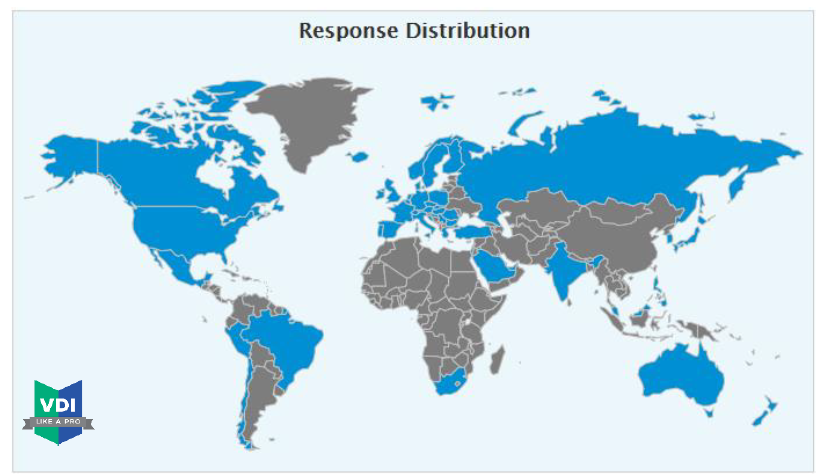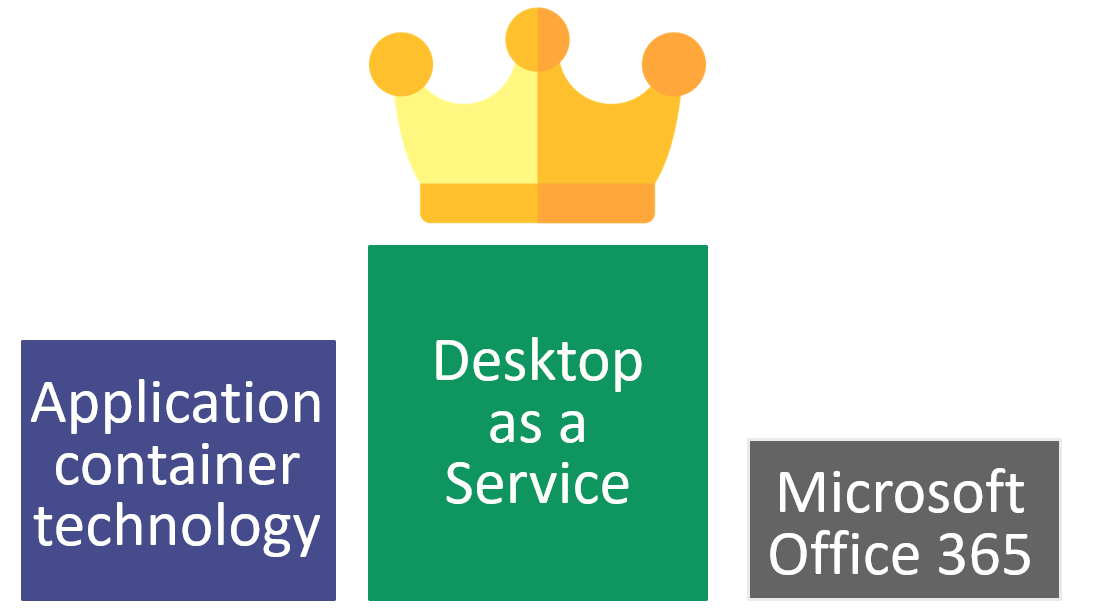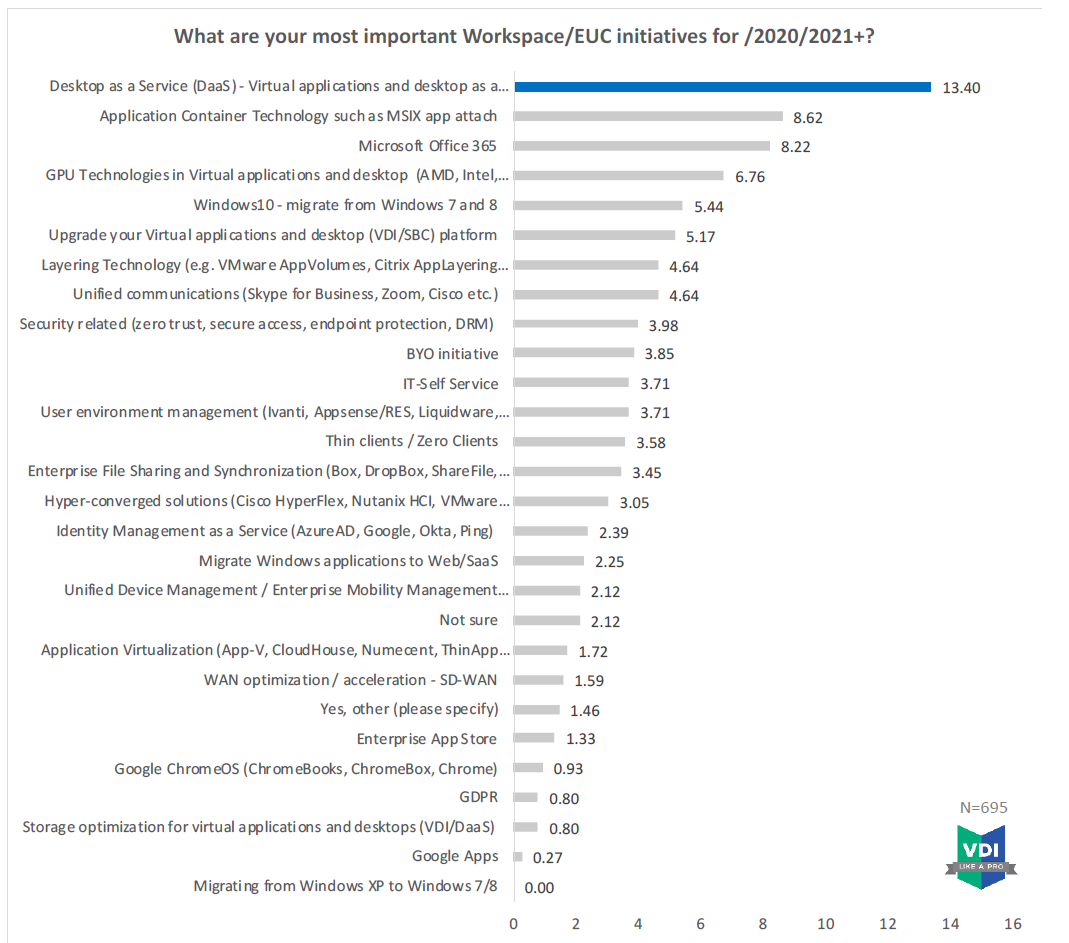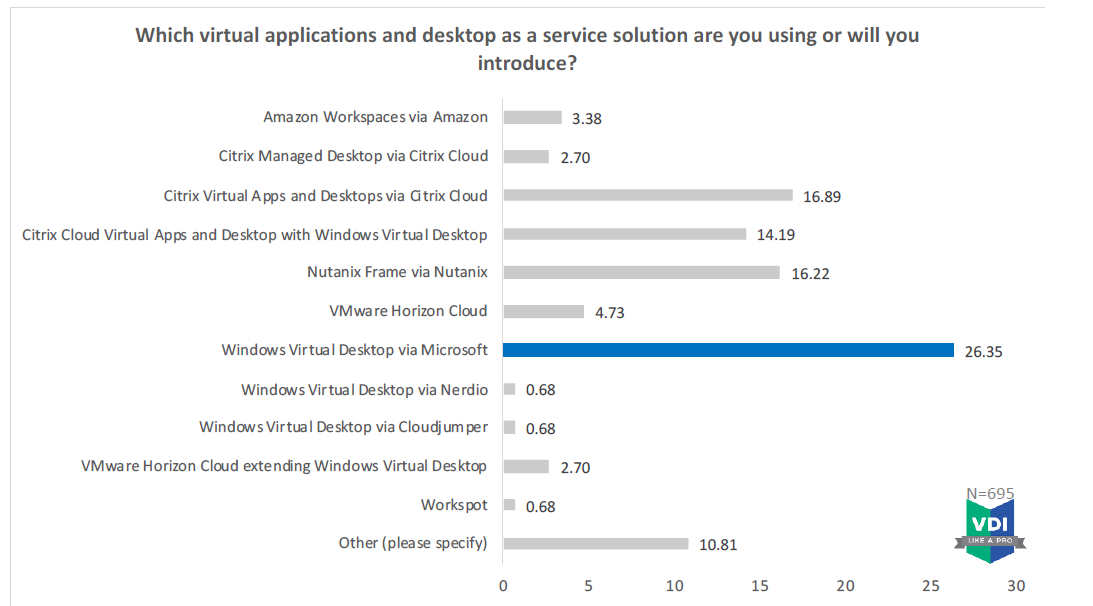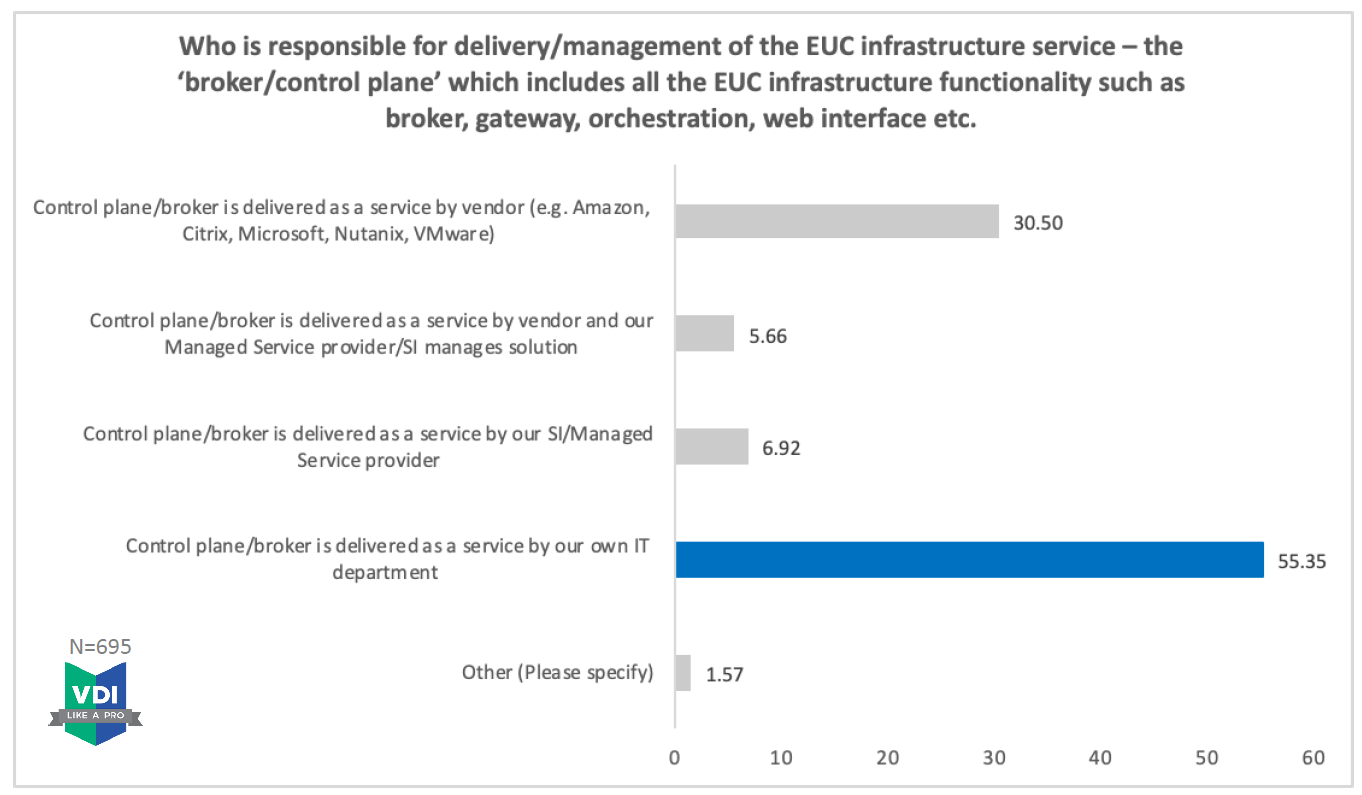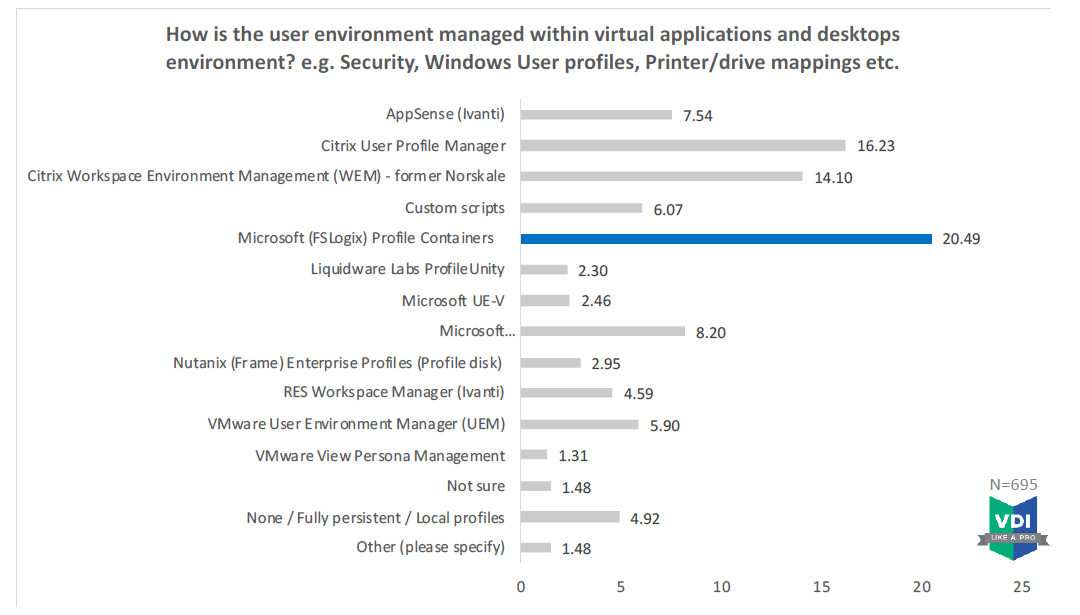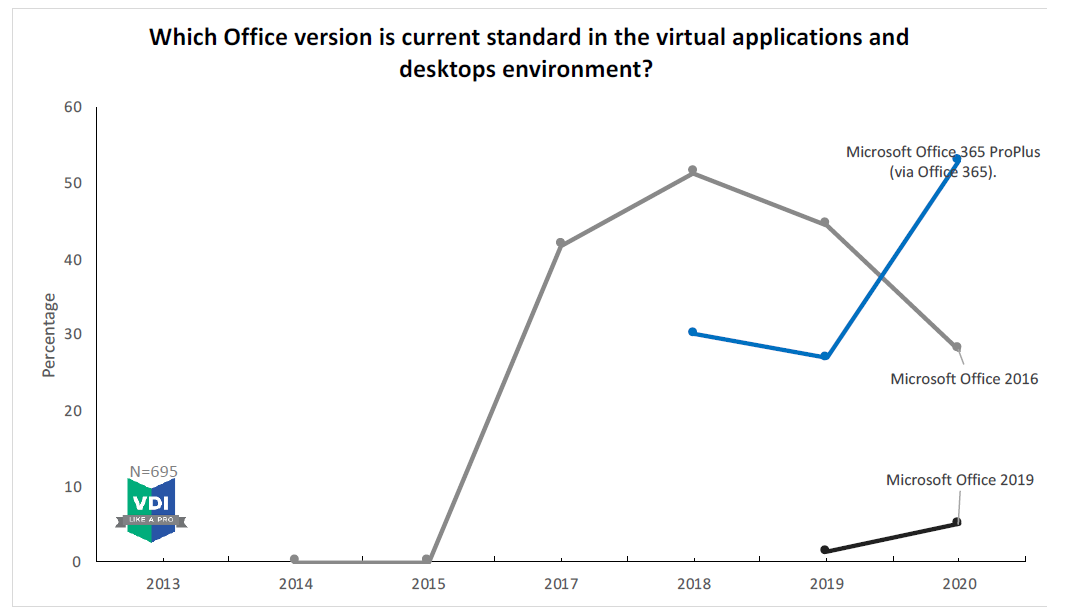
The #VDILIKEAPRO 2020 survey – industry highlights – go get all the valuable information about EUC/Workspace/VDI/DaaS community initiatives for 2020+ here
Yes, we did it again! The #VDILIKEAPRO 2020 survey has been released last week and the insights are great.
“If we have data, let’s look at data. If all we have are opinions, let’s go with….”
The ‘End User Computing – State of the Union’ is truly unique because it’s unbiased, independent, powered by the community and the results are available for everyone—free of charge.
The document provides valuable insights into trends, real-world deployments, configuration, and usage, both on-premises, and public cloud environments, from more than 695 people who supported the survey this year!
In this article, I’ll show some of the highlights of this year’s survey – to get a quick impression of the trends in the market.
Go get the complete – VDILIKEAPRO 2020 state of the union – survey here.
The change from VDI and SBC to virtual apps and desktops
In the 2019 state of the End User Computing union, we used ‘Virtual Desktop Infrastructure – VDI’ and ‘Server Based Computing – SBC’ terminology. This year and moving forward we will use single-user and multiuser operating system. The main reason for this change is the development of Desktop as a Service (DaaS) and the usage of different and new operating systems supporting single-user and multiuser sessions.
Also, it helps to create a better flow into the survey to address on-premises, public cloud, and hybrid scenarios of virtual applications and desktops. Important: when we compare 2020 survey results with 2019 and earlier, we have combined the single user (VDI) and multi-user (SBC) results into a single category called virtual applications and desktops.
Participant locations (695 people this year)
North America has the largest response distribution and is clearly the largest region by far. There is a relatively high number of participants from the Netherlands (17.9%), likely because VDI Like a Pro and their team members are well-connected with end-users, partners, and vendors in this region.
What is your most important Workspace/EUC initiatives for 2020/2021+?
The Top 3 of most important Workspace initiatives for 2020/2021 are:
- Desktop as a Service
- Application Containers such as MSIX app attach
- Microsoft Office 365
An interesting change of initiatives compared to 2019 which was:
- Windows 10 – migrate from Windows 7 and 8
- Microsoft Office 365
- Desktop as a Service
Clearly the large Windows 7/8 migration to Windows 10 is finished by the majority of respondents and new initiatives such as Desktop as Service and Application containers are on the roadmap for 2020/2021.
Which DaaS solution are you using, or will you introduce?
Azure Virtual Desktop seems to be on top of mind of the EUC Community. It not only received the largest percentage, partner solutions with e.g. Citrix and Azure Virtual Desktop as the second-largest number. It’d be interesting to see how this development looks next year.
Control-plane responsibility
The majority of respondents of the 2020 survey, 55.35%, is running and supporting the EUC infrastructure ‘broker’ as part of their own IT service while 30.5% is consuming the control plane or broker as a service.
In which phase is your Desktop-as-a-Service (DaaS) public cloud deployment currently?
37.34% of the of respondents are designing, running a Proof of Concept, pilot or run their Desktop as a Service solution in pre-production. 19.33% do use the solution in production for 1 year or less. 14.66% of the respondents do use DaaS in production for 2+ years.
How is the user environment managed?
Most of the organizations use the FSLogix Profile Container product from Microsoft this year, after the acquisition in 2018 – and the decision to make the product available for almost everyone has been an important decision point.
The total usage of Microsoft FSLogix profile containers is 20.49%. Citrix user environment management solutions is 16,23 % in 2020, VMware solutions is 7.21% and Appsense (Ivanti) declined from 8.32% in 2019 to 7.54% in 2020 while RES Workspace Manager (Ivanti) declined from 8.87% in 2019 to 4.59% in 2020.
Which Office version is the current standard in the virtual applications and desktops environment?
The adoption of Office 365 ProPlus increased from 26.95% in 2019 to 53% in 2020. Microsoft 2016 declined from 44.48% in 2019 to 28% in 2020. Google GSuite is being used in 1.58% of the deployments and slowly increasing but still minor compared to Microsoft.
Other highlights
- The audience that filled in this survey has been mostly technical with 47,48% followed by consultants (25,90%) and IT managers (11,75%).
- With 15.35% Finance became the largest business vertical market for virtual desktops and application solutions. Healthcare with 13.19% is 2nd and Government with 11.75% is 3rd largest vertical.
- 26.17% is using a multi-user operating system (with multiple users actively sharing the VM) while 22.74% is using a single-user operating system.
- With 37.25% Windows Server 2016 is used the most followed by Server 2019 with 20.24% and Server 2012R2 still used by 18.22% of the respondents. Windows 10 EMS (Enterprise multi-session) was introduced in 2019 and is used with 11.13% of the organizations.
- The majority of respondents in the 2020 survey are running their workload VMs to virtual desktops and applications in a private cloud environment using on-premises or co-located datacenters.
- A perfect virtual desktop and application solution is more common in 2020 with 10.90% an increase of 6.68% compared to 2019.
- VMware remains by far the largest vendor delivering virtual hypervisor infrastructure for virtual desktops and applications, although the usage is slowly decreasing from 65.8% in 2014, 64% in 2015 and 2016, 61.4% in 2018, 56% in 2019 and 55% in 2020. Microsoft Hyper-V usage is slowly decreasing from 13.18% in 2019 to 11% in 2020
- This year 59.5% of participants stated they didn’t have any plans to change their hypervisor while 7.53% is still investigating hypervisor options.
- The biggest GPU competitors isn’t AMD versus Intel versus NVIDIA—it’s the CPU (again). Many organizations think the CPU can handle the graphics-related activities and therefore don’t use GPUs. “No GPU” declined from 78% in 2014, 67% in 2016, 56% in 2017, 44.92% in 2018, 43.06% in 2019 and is at 35.41% in 2020.
- This year for the first time we asked if GPUs are using in public cloud. The majority of virtual desktop and application deployments aren’t using GPUs, 44.91% while NVIDIA NV instance types on Azure are using 21.56%.
- AMD is slowly entering the EUC space with promising EPYC CPUs and Radeon GPUs, the AMD GPUs have entered the public cloud space with Azure NVv4 machines but on-premises AMD GPUs unfortunately aren’t used a lot.
- Most of the organizations use the FSLogix Profile Container product from Microsoft this year, after the acquisition in 2018 – and the decision to make the product available for almost everyone has been an important decision point.
- The total usage of Microsoft FSLogix profile containers is 20.49%. Citrix user environment management solutions is 16,23 % in 2020, VMware solutions is 7.21% and Appsense (Ivanti) declined from 8.32% in 2019 to 7.54% in 2020 while RES Workspace Manager (Ivanti) declined from 8.87% in 2019 to 4.59% in 2020.
- The use of unified communications with voice and video support has increased rapidly from 13.4% in 2014, 30.6% in 2017, 37.90% in 2018, 38.72% in 2019 and 47.92% in 2020. While Unified Communications in virtual applications and desktops always is ‘attention’ and often challenging it is great to see usage increasing.
- We are surprised to see that IT Admins are increasingly using manually installation and update of OS and applications within the master image.
- 46.65% of the respondents do report that their complete application landscape does contains 80% or more Windows applications.
- Microsoft App-V still is the main application virtualization solution in virtual desktops and applications with 31.44% in 2019 and 30.41% in 2020.
- ControlUp is the most popular solution to monitor the virtual desktop and application environment, 13.01% of the respondents are using the solution which is an increase of 5.07% compared to 2019.
- A Unified Workspace portal will bring Windows, Web/SaaS applications and data together. A workspace portal often is referenced as “Workspace aggregator”. Citrix Workspace is used the most with 47.20% followed by VMware Workspace ONE with 14.91%. Also 23.60% of the respondents are investigating different options.
- With the increment working more from home, all dual-display configurations combined totals of 61.74% in 2020 an increase of 3.17% compared to 2019. Dual display at Full HD is used the most with 45.97% in 2020.
- Dual display configurations are more popular than a single display configuration at 31.21%. Dual display configuration surpassed a single display configuration in 2019. Ultrawide screen entered the survey with 0.67% in 2020.
- Cloud first strategy for virtual desktops and applications is the main reason for DaaS usage. 17,57% of the respondents in 2020 an increase of 3.94% compared to 2019.
- The four biggest challenges in adopting public cloud for Desktop as a Service (DaaS) are cost/positive business case (29.89%), Legal and regulation (13.30%), trust (11.21%), and performance (9.57%).
- The cloud strategy with regards to workload VMs for the majority of respondents is hybrid with 56.76%. A single public cloud strategy is second with 35.81% and multiple public cloud providers as strategy is being used by 7.43% of the respondents.
- The most important reason to use for Desktop as a Service is the ability to support flexible/temporary workers with 16.49%.
- The majority do have a hybrid data storage Desktop as a Service solution. 56.85% of the respondents do store data local / on-premises and use public cloud resources now or long term.
- The Top 3 of most important Workspace initiatives for 2020/2021 are; (1) Desktop as a Service, (2) Application Containers and (3) Microsoft Office 365.
We hope to see you back next year as participant!
THANK YOU.






